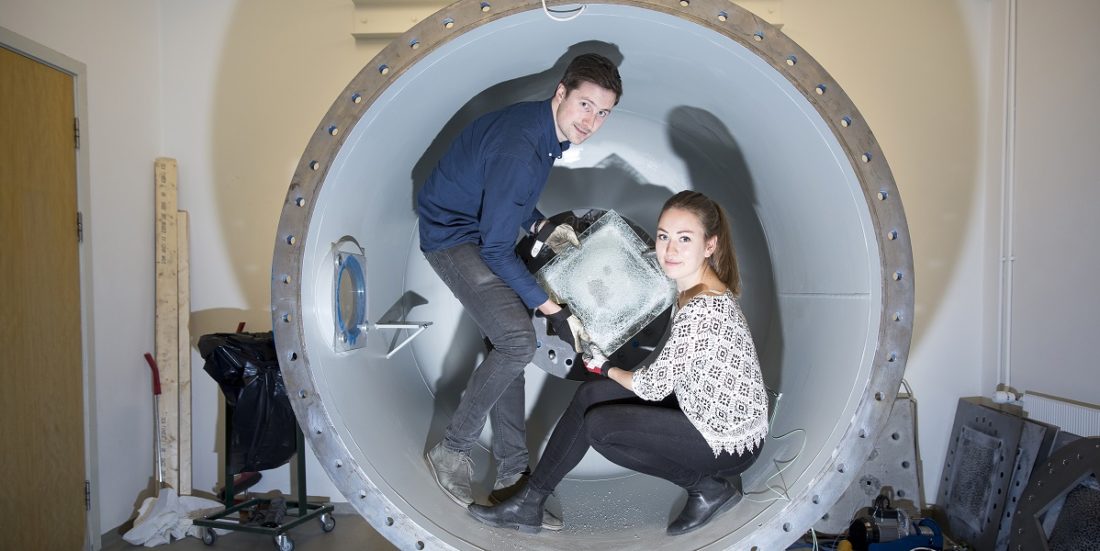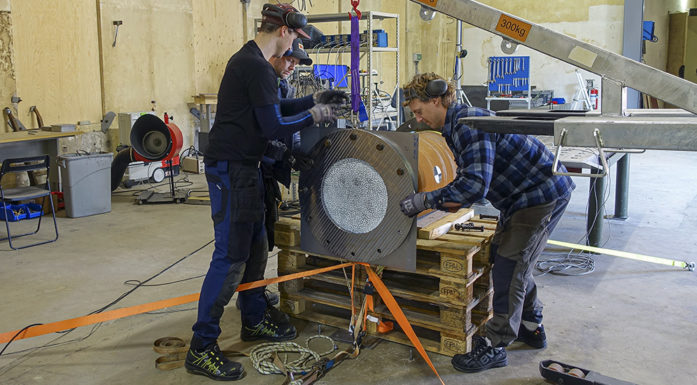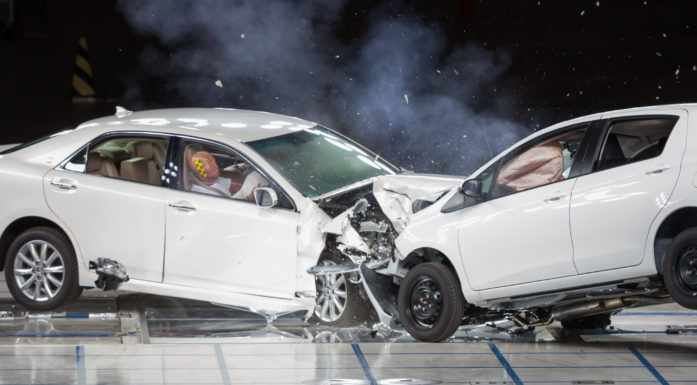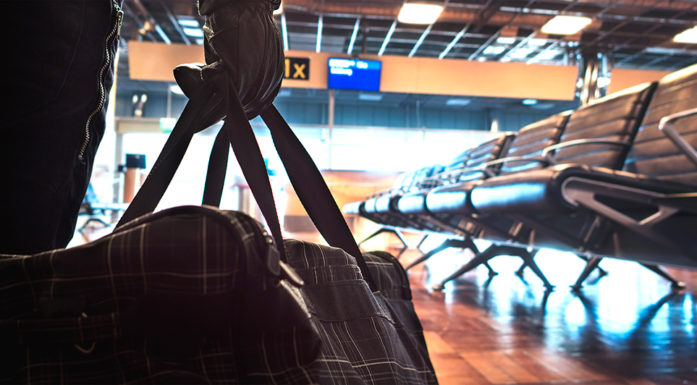A six-tonne tube helps make Norway’s government quarter safer
It weighs six tons, is 10 metres long, and is proving its usefulness in protecting the new government quarter, floating tunnels along Norway’s west coast and numerous other precious contraptions on a daily basis.
BUILDING SAFETY: The blast tube that was built for NTNU’s SIMLab cost NOK 6 million. When you pay that much for a steel tube, you naturally hope that it’s money well spent.
The price tag was almost ten times more than planned, as the tube became a lot more advanced during development. But its purpose also became a lot clearer. After July 22, 2011, when Norway was shaken by the nation’s worst ever terrorist attack in which 77 people were killed, everyone has a much better understanding of how important it is to protect public buildings and infrastructure.
With the shock tube in place, NTNU has completely new standards for testing how glass, metal, concrete and other materials react to explosions.
- You might also like: Creating the perfect collision
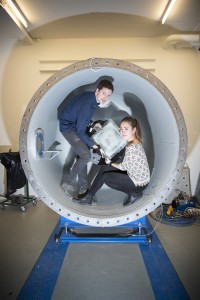
SIMLab’s shock tube at Gløshaugen. PhD candidates Vegard Aune and Karoline Osnes in the shock tube with a fragmented glass sample. Photo: Ole Morten Melgård
Does it work?
A year-and-a-half after its completion, the answer is inarguable: the tube works the way it’s meant to. Not only that. It has shown its uses in areas for which it was not originally intended.
One example is the “Ferry-free E39” project, run by the Norwegian Public Roads Administration. The idea is to turn the regional E36 highway into a floating tunnel in Sognefjord. The fjord is too deep to bury a tunnel underneath, and a suspension bridge would have to be 3.7 km long, almost twice as long as the world’s current longest suspension bridge.
Therefore, the blast tube is now being used to test how concrete reacts to explosive forces. The results of these tests will help determine which materials can be used to construct the proposed floating tunnel.
As shown in the video, the tests in the blast tube are yielding new information about how different qualities and thicknesses of concrete react to different types of explosive blasts.
- You might also like: Celebrity ice
Several series
Postdoc Martin Kristoffersen is involved in the “Ferry-free E39” project. He can confirm that their preliminary results are quite promising.
“The calibration tests showed that our blast tube is capable of providing consistent tests with predictable loads. A high-speed camera allows for close study of exactly what happens. The first series of tests using four different concrete plates went from no cracking, to surface cracks, to widespread cracks, and finally total collapse. This gives us a good idea of what load causes the concrete to crack,” he explains. “The second series of tests was to establish what benefit reinforcing the concrete has to a construction. The difference was primarily in the concrete’s crack pattern, which is more or less what was expected.”
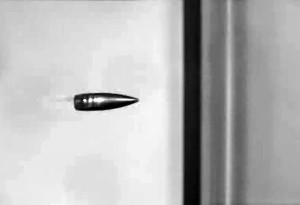
SIMLab’s researchers test how different construction materials and structures behave when exposed to extreme conditions, such as bomb explosions or shots from a rifle. Photo: NTNU
He concludes that the blast tube has proven to be versatile and capable of producing consistent tests, both important qualities for a good test rig.
An old dream
Arnfinn Jenssen, who was the Head of Research and Development at the Norwegian Defence Estates Agency (NDEA) at the time, was one of the first people to suggest that NTNU should build a blast tube in the 1990s.
Jenssen was a central player in securing political and economic support for building the research group known as SIMLab at the Faculty of Engineering Science and Technology.
Today, the group, now also host to CASA, is a world leader in studying how different materials and construction types react to different extreme loads, in no little part due to a well-equipped lab. The blast tube is the latest, most important part of the tool kit.
The story continues under the video.
Simulating an explosion. The glass splinters can do incredible damage. Photo: SIMLab, the Norwegian University of Science and Technology(NTNU)
Mentor
PhD candidate Vegard Aune has helped to build the blast tube since its beginnings. The terror attacks on July 22, 2011 speeded up the process significantly. This was when the decision was made relatively quickly to establish a PhD position working with the blast tube. Aune started in 2012. He is quick to acknowledge the contributions of another key player.
“Without Olav Fismen, this wouldn’t have happened,” he said.
An engineer with a background from AMA Trykkluft in Risør, Fismen was already long past retirement age. Nonetheless, his expertise was integral to building the world’s largest kicking machine and several of the other instruments in SIMLab, and now CASA’s laboratories.
“We had several limitations to consider. Among other things, we needed to be able to get the tube into the room we’d been given in the basement of the department’s building,” Aune explains. No small amount of number-crunching was required before Heimdal Industriservice could produce the actual tube in all of its glory.
The tube was formally opened for research in October of 2014.
Important contributors
The blast tube was one of the main reason that the Ministry of Local Government and Modernisation joined the Centre for Advanced Structural Analysis, known as CASA, for which NTNU’s SIMLab is a host.
“We need an research environment that will help us figure out construction approaches for the structures that are being built for today’s world,” says Deputy director general Christian Fredrik Horst at the Department for Buildings, Security and Services. “This includes simulating how explosions and fragments affect the whole structure, how resistant they are, and so on. We need to know that they can handle the stress from explosions or the like. Figuring out that they weren’t built strongly enough after a building is destroyed just isn’t an option.”
New materials
As part of this interest in building material qualities, the institute has started studying glass. There’s actually an enormous need for more knowledge on how glass reacts to explosions. PhD candidate Karoline Osnes is studying different types of glass, as well as polymers in different types of laminates.
Her findings will help affect how different materials are combined to make them safer and stronger.
“Bulletproof windows don’t help much if the whole building collapses,” Horst says.
Safer testing situations
The blast tube allows the testing of different materials under varied conditions in a much more controlled, safer manner than before. Vegard Aune has a good example of just how things can go wrong.
“In the spring of 2014, before the tube was finished, we did some experiments with NDEA at a military facility in eastern Norway,” he said. “After a long discussion, we decided to use a third of the amount of explosives we had originally planned to use for the test, but after the blast, there were glass fragments everywhere, and the light fixtures were dangling from the ceiling.”
